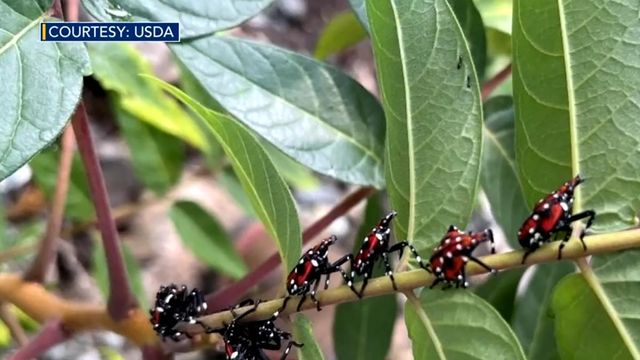Experts are asking you to smoosh these bugs
The North Carolina Department of Agriculture is asking people to watch out for the spotted lanternfly during their Fourth of July travels.
The spotted lanternfly, or Lycorma delicatula, is a beautiful creature with large brownish gray wings with black spots that open to reveal striking red underwings.
It is also an invasive species, not native to the United States and damaging to plants, people and property. The bug feeds on the sap of woody plants, sucking the life from grapevines and other varieties.
“They like the black walnut. They like a lot of maple species,” said Dr. Mirian Watts, an entomologist and teaching assistant professor of biology at East Carolina University. “And they like grapes. So that is the concern on the economic side … where they could cause loss, they could cause farmers to spend a lot more money” on control measures.
The insect is known to feed on a variety of plants, including grapes, apples, peaches and maple trees, and has more than 100 known hosts.
"Spotted lanternflies secrete a sticky substance called honeydew that attracts stinging insects and causes the growth of black sooty mold on anything under the canopy of an infested tree," according to the USDA.
- NCSU research shows invasive insect could spread to NC, damage crops in five years
- Invasive spotted lanternfly threatens North Carolina vineyards; Advice: Report it then kill it
The spotted lanternfly has no natural predators in the U.S. Spotted lanternflies are not harmful to humans or pets.
“We should come back to what is an invasive species,” Watts said. “They might be pretty, but they are causing harm to that native plant. That plant is suffering. That plant can actually die.
Watch for hitchhikers
There are well-established populations of spotted lanternflies all along the East Coast from Massachusetts to Virginia, as well as West Virginia, Ohio, Indiana and Michigan, so travelers arriving in North Carolina from those areas should be especially vigilant.
In North Carolina, Guilford and Forsyth counties are officially labeled as having infestations. Spotted lanternflies have been found in 14 other counties, including Onslow and Currituck in the east.
“We have been aggressively treating and surveying an area in Forsyth County where an established population of spotted lanternfly was found last year,” said Agriculture Commissioner Steve Troxler. “We don’t want to see this spread into our state, so the more eyes watching for this pest, the better.”
If you see a lanternfly, squash or stomp
If you see a spotted lanternfly, you should do the following:
Take a photo and report the sighting online at ncagr.gov/SLF.
Kill the insect. You can kill the insect by squishing it or placing it in a container of rubbing alcohol.
- Look for additional spotted lanternfly in the area. If your report is spotted lanternfly, you will be contacted by Plant Industry Division staff for more information.
Stomping and squishing are the best methods of eradication, experts say. You can also put sticky tape on tree trunks, rocks and fence posts where the bugs like to lay eggs. The dark gray egg masses blend in with tree bark, rocks, concrete and other materials. Once the tape is full and the bugs are dead, discard it. People are also encouraged to remove any egg masses they find on trees, rocks or other surfaces and use sticky bands around tree trunks to trap the insects or kill them.
The threat is so serious there is an app, called Squishr, to allow people to track all the lanternflies they kill.











